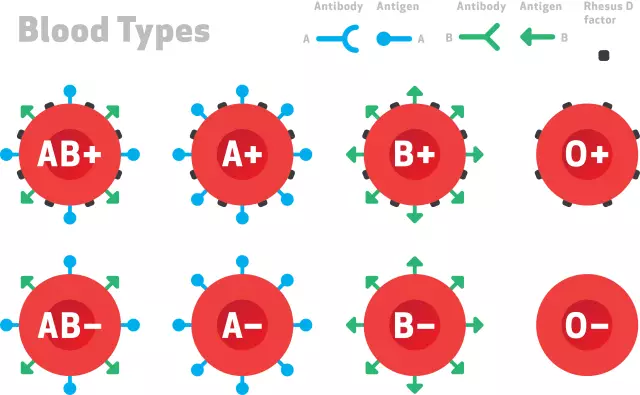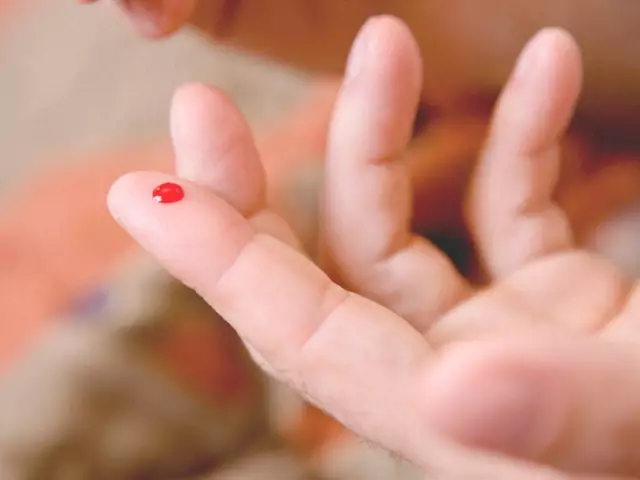- Author Curtis Blomfield [email protected].
- Public 2023-12-16 20:44.
- Last modified 2025-01-23 17:01.
Different people have approximately the same blood composition, it includes similar basic elements. True, there are eight types of blood, determined by the presence or absence of specific antigens. These components can cause reactions of the immune system if they are foreign to it. Blood is divided into four groups according to its type of antigens, and, in addition, into two large categories according to the Rh factor.

Let's consider this question in more detail.
How were blood types discovered?
Experiments aimed at the transfusion of blood and its components have been carried out for hundreds of years. For some, such treatment saved lives, although most people, unfortunately, died after transfusion. The reasons for this phenomenon remained unknown until 1901, when the Austrian doctor K. Landsteiner discovered the difference between the blood samples of patients.
Thus, during the experiments, the doctor noted that inIn some situations, mixing blood types of two patients could lead to agglutination, that is, to the process of agglutination of red blood cells. Then it turned out that such a process leads to fatal consequences. As it turned out then, the incompatibility of different people is caused by an immune response.
In the event that the recipient has antibodies directed against donor blood, then the immune system tries to get rid of such foreign cells. Landsteiner's work made it possible to isolate four groups of biomaterial and make transfusion safe. For this discovery, the scientist was awarded the Nobel Prize. Next, let's move on to considering the types of blood groups and find out how many of them are allocated in medicine.

Classification
The difference between blood in humans lies primarily in the presence or absence of a certain protein molecule called an antigen. Such a molecule is located on the surface of the red body of the erythrocyte and in the serum. It is these proteins that are responsible for the immune response to someone else's biological fluid.
Combinations of these molecules may vary from patient to patient. They directly depend on the genetic information that a person inherits from his parents. The group of this biomaterial is determined by the presence or absence of antigens "A" and "B" on the surface of the erythrocyte and antibodies to them in plasma.
In Russia, it is customary to call groups by numbers, namely, there is a second, first, third and fourth. International practice designates blood types in vessels according to the "AB0" system,where 0 is the first group, A is the second, B is the third, and AB is the fourth:

- The first blood type has antibodies only in plasma.
- The second has an "A" antigen on the surface of the erythrocyte, and, in addition, "B" antibodies in the blood plasma.
- The third group has antigen "A" in the blood plasma and "B" on the surface of the erythrocyte.
- The fourth group has antigens "A" and "B" directly on the surface of the erythrocyte.
It is important to find out in advance what type of blood the patient is.
Now consider what the Rh factor is.
How do Rh factors differ?
In addition to antigens "A" and "B" on the surface of the erythrocyte, patients also have the Rh factor. This is also such a kind of antigen that eighty-five percent of Europeans have. It is also observed in ninety-nine percent of Asians. Such people are called Rh-positive, they are designated by the indicator "RH +". Those who do not have an Rh factor in their blood are called Rh-negative patients with an “RH-” indicator.

If blood is transfused from one RH- negative person to a positive person, there is usually no problem. In the opposite situation, Rh antibodies can begin to be produced in the recipient's blood, leading to the destruction of red blood cells. Given the presence of the Rh factor, there are as many as eight blood types in medicine.
What happens if you mix blood from different groups?
In the event that the blood types of the recipient and donor are incompatible, then agglutination occurs in the form of agglutination of red blood cells against the background of antigen interaction processes. A similar process occurs if, for example, a person with type "B" receives the blood of a patient with type "A".
Agglutinated erythrocytes clog blood vessels and stop the circulation of biological fluid. Such a process may resemble the formation of blood clots, however, it is caused by several other reasons. In addition, broken red blood cells lose hemoglobin, which, being outside the cell, acquires toxicity. This can be fatal.
Compatibility of different blood types
Despite the difference in the content of antigens, in a number of certain cases it is possible to transfuse from a donor to recipients with different groups. Transfusion will be safe only if the recipient does not have antibodies to the donor's antigens. So, patients with blood type "0 Rh-" are considered universal donors, because they do not have antigens and Rh factor on the surface of the erythrocyte. People with the "AB Rh +" group are universal recipients, because in the plasma of their biomaterial there are no antibodies to the antigen and there is a Rh factor.
It is also worth saying that the blood of different people is approximately the same in composition, however, it may differ in the content of certain antibodies. This makes it possible to divide it into as many as eight groups. The ideal donor is a person with the same group and Rh factor as the recipient.
Next, consider blood cells and their types.

Blood cell types
There are many types of cells in the blood that perform very different functions, from transporting oxygen to producing antibodies. It is worth noting that some of these cells function only within the circulatory system, while the rest use it only for transportation, and perform their functions in completely different places.
What are these cells?
Blood cells: leukocytes and erythrocytes
Blood cells are divided in medicine into red and white elements (that is, into leukocytes and erythrocytes). The latter remain in the blood vessels, carrying oxygen with carbon dioxide. In addition, they are directly related to hemoglobin. Erythrocytes are the bulk of the cells that circulate in the blood, are densely filled with hemoglobin and do not include any conventional cellular organelles. Leukocytes, as a rule, fight various infections by digesting the remnants of destroyed blood cells. To do this, they pass through the walls of small blood vessels into the tissue. Now let's talk about the types of blood tests that are performed as part of the diagnosis when a patient is suspected of having a specific disease.
Types of blood tests
In medicine, there are the following types of tests, which, if necessary, are prescribed to patients:

- Clinical or biochemical analysis.
- Conducting a study on the concentration of glucose.
- Performing immunoassay.
- Study of the hormonal profile and coagulogram.
- Performing an analysis for the determination of tumor markers.
- Performing a polymerase chain reaction.
Blood tests not only allow you to determine the presence of the disease, but also help to monitor the result of therapy. Studies of biological fluid are very important for the diagnosis of various diseases. It is in connection with this that many people are interested in the question of what blood tests are. In fact, there are a considerable number of them, and absolutely all of them are prescribed by a doctor, depending on specific cases of pathology.

For example, blood from capillaries as part of a general analysis is obtained by puncturing the phalanx of a finger on a hand with a special disposable sterile pen. To perform biochemistry, biomaterial from a vein is used. In addition, there are other laboratory tests that are carried out to determine sugar, hormones, tumor markers and other types of tests.
We looked at human blood types, cells and types of biological fluid studies.






